Lesson 4
What Fraction of a Group?
4.1: Estimating a Fraction of a Number (5 minutes)
Warm-up
In this warm-up, students estimate the value of a fraction of a number (e.g., \(\frac13\) of 7) using what they know about the size of the given fraction. Then, they write multiplication expressions to represent the verbal questions. The goal is to activate prior understandings that a fraction of a number can be found by multiplication, preparing students to explore division problems in which the quotient is less than 1 whole.
Launch
Ask students to keep their materials closed. Display one estimation question at a time. (If all questions are displayed, ask students to work on one question at a time and to begin when cued.) Give students 30 seconds of quiet think time per question and ask them to give a signal when they have an answer and can explain their strategy.
Select 1–2 students to briefly share their estimates and how they made them. Record and display their estimates for all to see. After discussing the third estimation question, ask students to write a multiplication expression to represent each of the three questions.
Student Facing
-
Estimate the quantities:
- What is \(\frac13\) of 7?
- What is \(\frac45\) of \(9\frac23\)?
- What is \(2\frac47\) of \(10\frac19\)?
- Write a multiplication expression for each of the previous questions.
Student Response
For access, consult one of our IM Certified Partners.
Anticipated Misconceptions
Some students may try to find the exact answers to the questions instead of estimating. Encourage them to think about benchmark fractions that could help them estimate.
Activity Synthesis
Ask a few students to share the expressions they wrote for the questions. Record and display the expressions for all to see. Ask the class to indicate if they agree or disagree with each expression.
If not already brought up in students’ explanations, highlight the idea that we can find the exact value of a fraction of a number (e.g., \(\frac45\) of \(9\frac23\)) by multiplying the fraction and the number. It does not matter whether the number is a whole number, a mixed number, or another fraction.
To involve more students in the conversation, consider asking:
- “Who can restate ___’s reasoning in a different way?”
- “Did anyone solve the problem the same way but would explain it differently?”
- “Did anyone solve the problem in a different way?”
- “Does anyone want to add on to _____’s strategy?”
- “Do you agree or disagree? Why?”
4.2: Fractions of Ropes (10 minutes)
Activity
This task helps to transition students from thinking about “how many groups?” to “what fraction of a group?”.
Students compare different lengths of ropes and express their relative lengths in multiplicative terms. Rope B and C are 5 and \(2\frac12\) times as long as rope A, respectively, but rope D is shorter than rope A, so then we say that it is \(\frac34\) times as long as rope A. They see that it is possible that the answer to a “how many groups?” question is a number less than 1 when the given amount is smaller than the size of a group.
As students work, notice how they go about making multiplicative comparisons. Select students who write clear and concise questions for the equations in the last problem so they can share later.
Launch
Arrange students in groups of 2. Give students 4–5 minutes of quiet think time and then a couple of minutes to compare their responses with a partner and discuss any disagreements. Clarify that rope A is 4 units long.
Students using the digital materials can use the applet at ggbm.at/kZUgANCC to compare the segments. The segments can be moved by dragging endpoints with open circles. The yellow “pins” can help students keep track of the groups.
Student Facing
The segments in the applet represent 4 different lengths of rope. Compare one rope to another, moving the rope by dragging the open circle at one endpoint. You can use the yellow pins to mark off lengths.
- Complete each sentence comparing the lengths of the ropes. Then, use the measurements shown on the grid to write a multiplication equation and a division equation for each comparison.
- Rope B is _______ times as long as rope A.
- Rope C is _______ times as long as rope A.
- Rope D is _______ times as long as rope A.
-
Each equation can be used to answer a question about Ropes C and D. What could each question be?
-
\({?} \boldcdot 3=9\) and \(9 \div 3={?}\)
-
\({?} \boldcdot 9=3\) and \(3 \div 9= {?}\)
-
Student Response
For access, consult one of our IM Certified Partners.
Launch
Arrange students in groups of 2. Give students 4–5 minutes of quiet think time and then a couple of minutes to compare their responses with a partner and discuss any disagreements. Clarify that rope A is 4 units long.
Students using the digital materials can use the applet at ggbm.at/kZUgANCC to compare the segments. The segments can be moved by dragging endpoints with open circles. The yellow “pins” can help students keep track of the groups.
Student Facing
Here is a diagram that shows four ropes of different lengths.
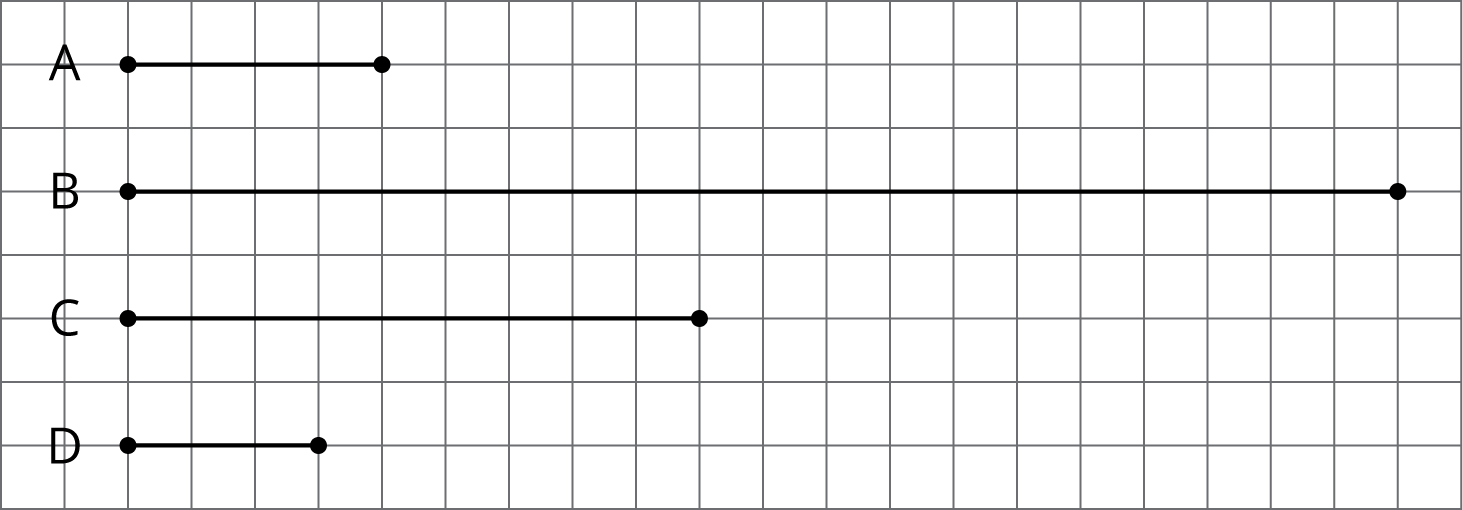
-
Complete each sentence comparing the lengths of the ropes. Then, use the measurements shown on the grid to write a multiplication equation and a division equation for each comparison.
-
Rope B is _______ times as long as Rope A.
-
Rope C is _______ times as long as Rope A.
-
Rope D is _______ times as long as Rope A.
-
-
Each equation can be used to answer a question about Ropes C and D. What could each question be?
-
\({?} \boldcdot 3=9\) and \(9 \div 3={?}\)
-
\({?} \boldcdot 9=3\) and \(3 \div 9= {?}\)
-
Student Response
For access, consult one of our IM Certified Partners.
Anticipated Misconceptions
Some students might associate the wrong lengths with the ropes or confuse the order of comparison (e.g., comparing A to C instead of C to A). Encourage them to put the length of each rope next to the diagram and attend more closely to the ropes being compared.
Activity Synthesis
Display the solutions to the first set of problems for all to see. Give students a minute to check their answers and ask questions. Then, focus class discussion on two key ideas:
-
The connection between “how many groups?” questions and “how many times as long?” questions. Ask students how these two types of questions are similar and different. Make sure students see that both have the structure of \(? \boldcdot a =b\), where \(a\) is the size of 1 group (or the unit we are using for comparison), and \(b\) is a given number.
-
The language commonly used when referring to a situation in which the number of groups is less than 1 whole. Explain that we have seen equal-sized groups where the number of groups is greater than 1, but some situations involve a part of 1 group. So instead of saying “the number of groups” or asking “how many groups?,” we would ask “what fraction of a group?” or “what part of a group?”. For example, in the case of rope D, where the answer is less than 1, we can ask, “What fraction of rope A is rope D?”
Ask 1–2 previously identified students to share the question they wrote for the last pair of equations (\(? \boldcdot 9=3\) and \(3 \div 9= ?\)). Make sure students see that this pair of equations represent a situation with a fractional group
(i.e., rope D is shorter than rope C, so the length of rope D is a fraction of that of rope C).
Supports accessibility for: Visual-spatial processing; Conceptual processing
Design Principle(s): Support sense-making; Optimize output (for comparison)
4.3: Fractional Batches of Ice Cream (20 minutes)
Activity
In this activity, students make sense of quotients that are less than 1 and greater than 1 in the same context. Later in the task, students generalize their reasoning to solve division problems (where the quotient is less than 1) without contexts.
Given the amount of milk required for 1 batch of ice cream (i.e., the size of 1 group), students find out how many batches (i.e., the number of groups or what fraction of a group) can be made with different amounts of milk. They continue to use tape diagrams and write equations to reason about the situations, but this time, they are not prompted to write multiplication equations.
As students work, identify students students who drew clear and effective diagrams for the ice cream problems. Select them to share later.
Launch
Keep students in groups of 2. Display an example of a tape diagram that students have used in a previous lesson. The diagram for the question “how many \(\frac45\)s are in 2?” from a previous cool-down is shown here.
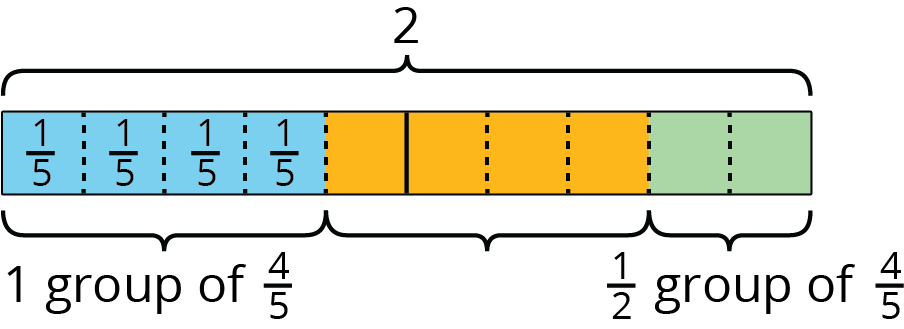
Point out how the diagram shows both full groups of \(\frac45\) and a partial group. Tell students that they will see more situations involving partial groups in this activity.
Give students 6–8 minutes of quiet work time for the first two sets of questions about ice cream. Ask students to make a quick estimate on whether each answer will be greater than or less than 1 before solving the problem. Provide access to colored pencils, as some students may find it helpful to identify whole groups and partial groups on a tape diagram by coloring.
Give students 2–3 minutes to discuss their responses with their partner. Follow with a whole-class discussion before students return to the last set of questions.
Ask previously identified students to share their diagrams for the ice cream problems, or display the following diagrams.
Monday and Tuesday:
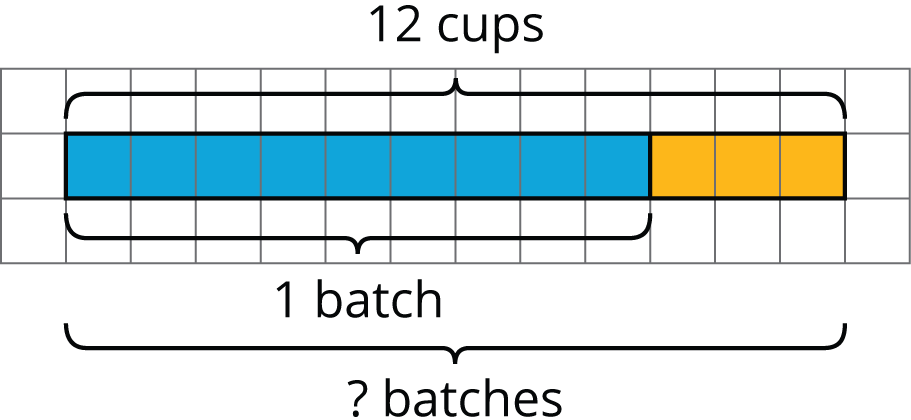

Thursday and Friday:

To help students see the structure in the diagrams, ask: “How are the diagrams for Monday and Tuesday like and unlike those for Thursday and Friday?” If not brought up in their responses, point out that:
- The size of 1 group (or the amount of milk in 1 batch) is the same in all diagrams, but the amounts we are comparing to 1 group vary. Those amounts are greater than 1 batch (9 cups) on Monday and Tuesday, and less than 1 batch on Thursday and Friday.
- This comparison to the size of 1 group is also reflected in the questions. We ask “how many batches?” for the first two, and “what fraction of a batch?” for the other two.
To help students notice the structure in the equations, ask: “How are the division equations for Monday and Tuesday different than those for Thursday and Friday? How are they the same?”
\(\displaystyle 12 \div 9 = ?\)
\(\displaystyle 22 \frac 12 \div 9 = ?\)
\(\displaystyle 6 \div 9 = ?\)
\(\displaystyle 7 \frac 12 \div 9 = ?\)
Highlight that, regardless of whether the answer is greater than 1 or less than 1, the equations show that the questions “how many batches (of 9 cups)?” and “what fraction of a batch (of 9 cups)?” can be expressed with a division by 9, because the multiplication counterparts of these situations all have the structure of “what number times 9 equals a given amount of milk?” or \(\displaystyle {?} \boldcdot 9 = b\) where \(b\) is a given amount of milk.
Give students quiet time to complete the last set of questions.
Design Principle(s): Support sense-making
Student Facing
One batch of an ice cream recipe uses 9 cups of milk. A chef makes different amounts of ice cream on different days. Here are the amounts of milk she used:
- Monday: 12 cups
- Tuesday: \(22 \frac12\) cups
- Thursday: 6 cups
- Friday: \(7 \frac12\) cups
-
How many batches of ice cream did she make on these days? For each day, write a division equation, draw a tape diagram, and find the answer.
- Monday

- Tuesday

- Monday
-
What fraction of a batch of ice cream did she make on these days? For each day, write a division equation, draw a tape diagram, and find the answer.
- Thursday

- Friday

- Thursday
-
For each question, write a division equation, draw a tape diagram, and find the answer.
- What fraction of 9 is 3?

- What fraction of 5 is \(\frac 12\)?

- What fraction of 9 is 3?
Student Response
For access, consult one of our IM Certified Partners.
Anticipated Misconceptions
If students are not sure how to begin representing a situation with a tape diagram, ask them to represent one quantity or number at a time. For example, they could begin by showing the amount of milk used as a tape with a particular length, and then mark the second quantity (the amount of milk in 1 batch) on the same tape and with the same starting point. Or they could represent the amounts in the opposite order.
Activity Synthesis
After students worked on the last set of problems, discuss the question “what fraction of 5 is \(\frac12\)?” To help students connect this question to previous ones, consider asking:
- “How can we tell if the answer is greater than 1 or less than 1 before calculating?” (The phrase “what fraction of” offers a clue that it is less than 1. Or, we are comparing \(\frac 12\) to 5 and can see that \(\frac 12\) is less than 5.)
- “What is the size of 1 group here? How do we know?” (We can tell that 5 is the size of 1 group because that is the value to which another number is being compared.)
- “How do we write a multiplication equation for this question? A division equation?” (\({?} \boldcdot 5 = \frac 12\), and \(\frac 12\div 5 = {?}\))
Select a student to display a correct diagram for the problem, or display this diagram for all to see. Discuss how the two given values and the solution are represented in the diagram.
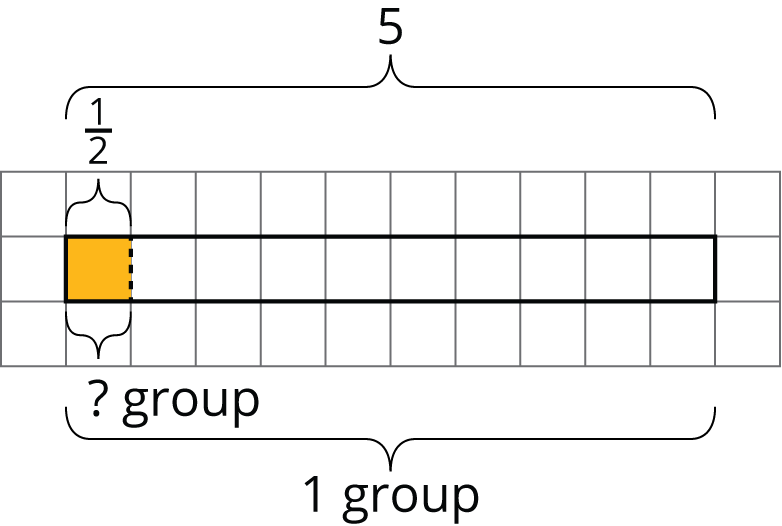
Lesson Synthesis
Lesson Synthesis
In this lesson, we saw that a division problem can represent the idea of equal-sized groups but may have a total amount that is less than the size of one full group. Instead of “how many of this is in that?”, the question is now “what fraction of this is that?”.
- “How can we tell if a division situation involves less than one whole group?” (The total amount is less than the size of the a group, or the question asks “what fraction of. . .?”)
- “How do we find quotients that are less than 1?” (We can write a multiplication equation that corresponds to the situation and draw a tape diagram to help us reason about what fraction of 1 group the given amount is.)
We also explored division problems as representing the answers to comparison questions about measurement. Instead of “how many groups?”, we can ask “how many times as long (or as heavy)?” For example: \(16 \div 4 = \,?\) corresponds to \(? \boldcdot 4 = 16\), which can represent the question “how many times as long as 4 cm is 16 cm?” We can reason that 16 cm is 4 times as long as 4 cm.
In the same context, \(3 \div 4\) corresponds to \(? \boldcdot 4 = 3\), and would mean “how many times as long as 4 cm is 3 cm?” Here, we can see that the answer will be a fraction less than 1. Because 3 is \(\frac34\) of 4, we can say “3 cm is \(\frac34\) as long as 4 cm.”
4.4: Cool-down - A Partially Filled Container (5 minutes)
Cool-Down
For access, consult one of our IM Certified Partners.
Student Lesson Summary
Student Facing
It is natural to think about groups when we have more than one group, but we can also have a fraction of a group.
To find the amount in a fraction of a group, we can multiply the fraction by the amount in the whole group. If a bag of rice weighs 5 kg, \(\frac34\) of a bag would weigh (\(\frac34 \boldcdot 5)\) kg.
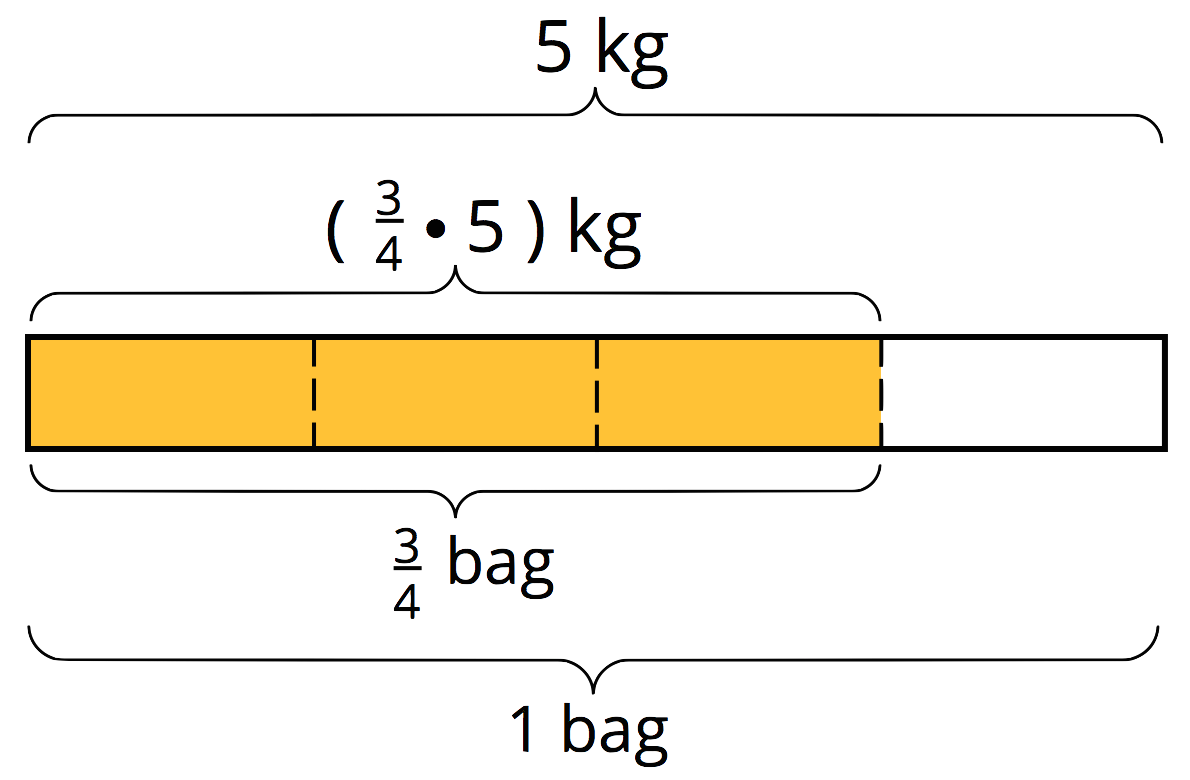
Sometimes we need to find what fraction of a group an amount is. Suppose a full bag of flour weighs 6 kg. A chef used 3 kg of flour. What fraction of a full bag was used? In other words, what fraction of 6 kg is 3 kg?
This question can be represented by a multiplication equation and a division equation, as well as by a diagram.
\(\displaystyle {?} \boldcdot 6 = 3\) \(\displaystyle 3\div 6 = {?}\)
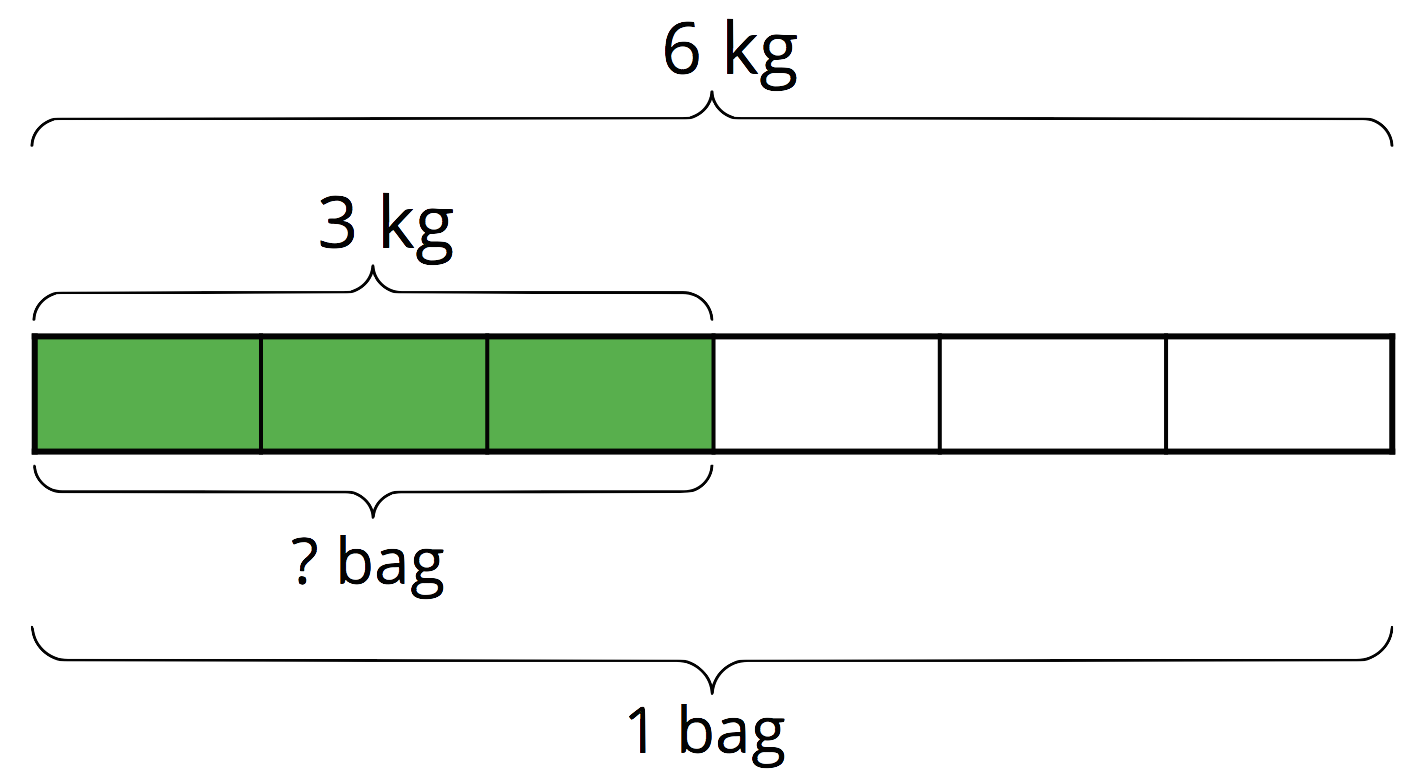
We can see from the diagram that 3 is \(\frac12\) of 6, and we can check this answer by multiplying: \(\frac12 \boldcdot 6 = 3\).
In any situation where we want to know what fraction one number is of another number, we can write a division equation to help us find the answer.
For example, “What fraction of 3 is \(2\frac14\)?” can be expressed as \({?} \boldcdot 3 = 2\frac14\), which can also be written as \(2\frac14\div 3 = {?}\).
The answer to “What is \(2\frac14 \div 3\)?” is also the answer to the original question.
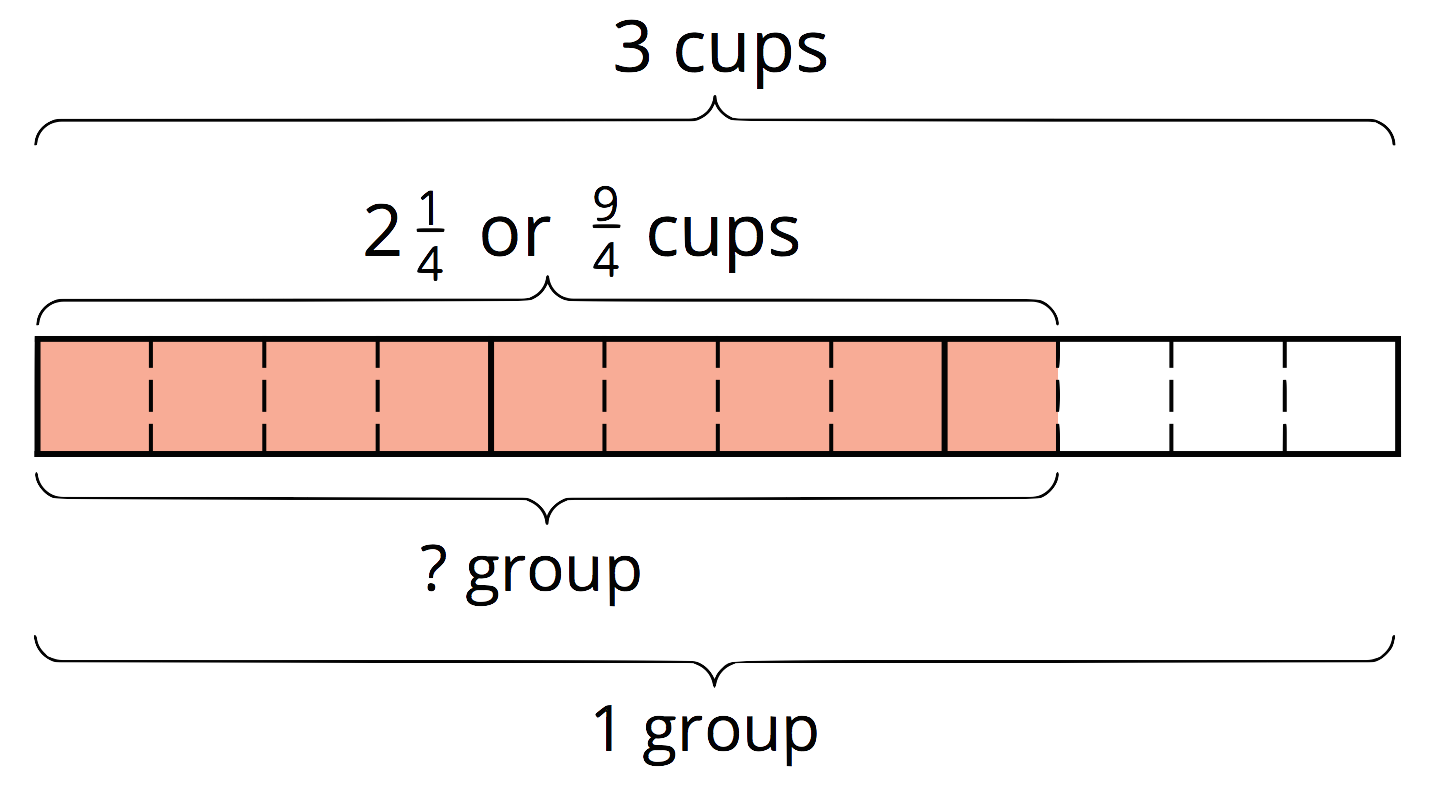
The diagram shows that 3 wholes contain 12 fourths, and \(2\frac14\) contains 9 fourths, so the answer to this question is \(\frac{9}{12}\), which is equivalent to \(\frac34\).
We can use diagrams to help us solve other division problems that require finding a fraction of a group. For example, here is a diagram to help us answer the question: “What fraction of \(\frac94\) is \(\frac32\)?,” which can be written as \(\frac32 \div \frac94 = {?}\).
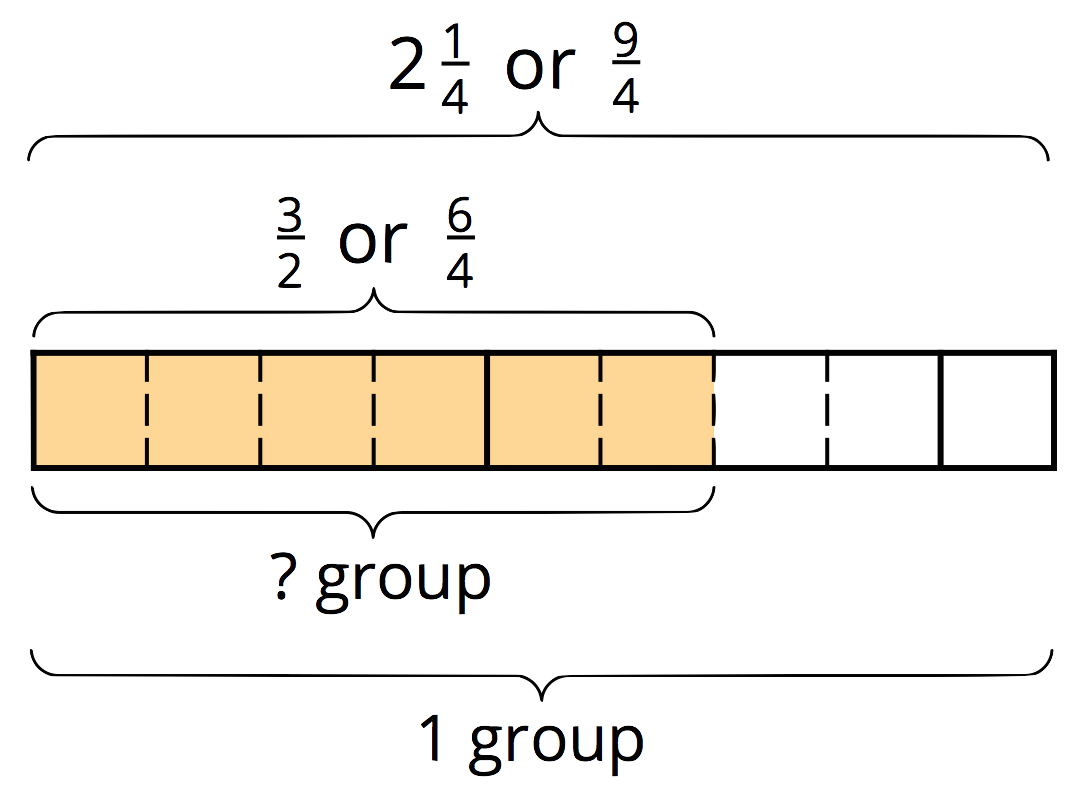
We can see that the quotient is \(\frac69\), which is equivalent to \(\frac23\). To check this, let’s multiply. \(\frac23 \boldcdot \frac94 = \frac{18}{12}\), and \(\frac{18}{12}\) is, indeed, equal to \(\frac32\).